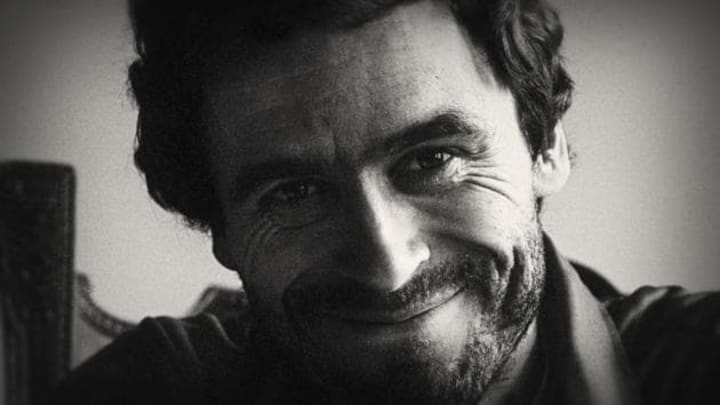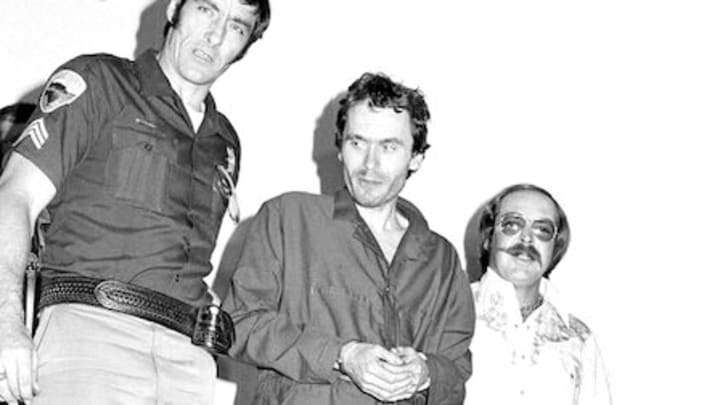
Ted Bundy was a notorious American serial killer, kidnapper, and rapist who murdered at least 30 people during the 1970s. He was born Theodore Robert Cowell on November 24, 1946, in Burlington, Vermont, to Eleanor Louise Cowell (1924–2012), who was unmarried and 21 years old at the time. Ted was raised to believe that his grandparents, Samuel and Eleanor Cowell, were his parents and his mother was his sister. Ted Bundy's family and early life have been described as turbulent, and he had a difficult relationship with his stepfather, who he claimed physically abused him.
Bundy's first known murder occurred in 1974, but it wasn't until 1975 that he began his killing spree in earnest. He targeted young, attractive women, many of whom had long, dark hair parted in the middle, similar to Bundy's first girlfriend, who broke up with him and he blamed for his killing behavior. His victims were typically last seen alive at colleges or universities, and most were killed in their own homes.
Bundy was eventually arrested in 1975 and was charged with several counts of murder in Colorado and Florida. He escaped from prison twice (once in 1977 and again in 1978) before being recaptured in Florida in 1978. He was tried, convicted, and sentenced to death in 1979 for the murder of two Florida State University students, and he received additional death sentences for other murders. He was executed in 1989 in Florida's electric chair.
Bundy admitted to 30 killings, but some investigators believe the number of people he killed may be closer to 100. His case has been the subject of numerous books, TV shows, and movies, with some of the more popular depictions being "Ted Bundy: Falling for a Killer" and "Extremely Wicked, Shockingly Evil and Vile"

Ted Bundy's modus operandi, or MO, was characterized by a pattern of behavior that he repeated in many of his crimes.
One of the key elements of Bundy's MO was his ability to gain the trust of his victims. He would often pretend to be injured or incapacitated in order to approach them, and would then offer to help or ask for assistance. This allowed him to get close to his victims and get them to lower their guard.
Once he had his victims in a vulnerable state, Bundy would then attack them. Many of his victims were bludgeoned, raped, and strangled, and some were found with bite marks on their bodies. Others were killed by manual strangulation. He also kept trophies from his victims, including driver's licenses and other identification cards, which he later used to impersonate his victims.
Bundy was known to have a preference for young, attractive women, many of whom had long, dark hair parted in the middle, similar to his first girlfriend, who broke up with him and he blamed for his killing behavior. He often targeted college students or women who were last seen in university or college campuses. His victims were also killed in their own homes, near their homes or in apartments and dorms on the campuses.
Bundy was also known for being highly intelligent and skilled at evading capture. He would often change his appearance, using disguises and altering his hair color and style to avoid detection. He also used various vehicles, often stealing them from his victims, to move around and avoid being tracked by police.
It is important to note that while there is a general pattern of MO, each of the crime scenes and each of the victims had different particularities and not all of them shared the same modus operandi. Additionally, Bundy had periods of inactivity in between his sprees, complicating the understanding of his MO as well.

The investigation into Ted Bundy's crimes was extensive and lasted for several years. It involved multiple law enforcement agencies and jurisdictions, as his victims were found in several different states.
The investigation began in the mid-1970s, when a number of young women began disappearing in the Pacific Northwest. At first, there was little evidence linking the disappearances, but as the number of victims grew, the pattern became clear. Police began to notice similarities between the victims, including their youth, attractiveness, and long, dark hair. They also noticed that many of the victims had been last seen in or around college campuses.
As the investigation continued, police were able to link some of the murders to Bundy through forensic evidence, such as bite marks, and through witnesses who had seen him with some of the victims. In 1975, he was arrested for the first time and charged with several counts of murder in Colorado and Florida.
Despite being arrested, Bundy managed to escape from prison twice (once in 1977 and again in 1978) before being recaptured in Florida in 1978. During his time on the run, he continued to kill and was eventually linked to a number of other murders.
After his capture, Bundy was charged with several counts of murder and was tried, convicted, and sentenced to death in 1979 for the murder of two Florida State University students. He received additional death sentences for other murders.
It is important to mention that the investigation was not easy and it was hampered by problems like lack of cooperation between police department, lack of forensic science capabilities, mistakes in the investigation and lack of communication between departments. Additionally, at the time it was not common for serial killer cases to be investigated in a coordinated way, hence cases went on individually making the pattern of crimes harder to spot.

Ted Bundy confessed to 30 killings, but the actual number of people he killed may be higher. The majority of his victims were young women, many of whom he targeted while they were in college or university. He would often approach them pretending to be injured or incapacitated, and then attack them once they were in a vulnerable state.
Bundy's known victims were killed between 1974 and 1978, and their bodies were discovered in several states, including Colorado, Utah, Oregon, Washington, and Florida. His killings began in Washington State, where at least six women are believed to have been killed. He then moved on to Colorado, where he killed two women, before heading to Utah, where he killed five women. He then headed back to the Pacific Northwest, where he killed four more women in Oregon, and several more in Washington. He committed most of his known murders in Florida, where he killed five women in a span of just 15 days in early 1978.
Many of Bundy's victims were bludgeoned, raped, and strangled, and some were found with bite marks on their bodies. Others were killed by manual strangulation. He also kept trophies from his victims, including driver's licenses and other identification cards, which he later used to impersonate his victims.
It is important to note that Bundy's killing sprees took place decades ago and that criminology has advanced greatly since then, so new information about his kills can emerge.

In conclusion, Ted Bundy was a notorious American serial killer, kidnapper, and rapist who murdered at least 30 people during the 1970s. His murders, primarily of young women, took place in several states and left a trail of fear and sorrow in the communities where the crimes occurred.
Bundy's modus operandi was characterized by a pattern of behavior in which he would gain the trust of his victims, often by pretending to be injured or incapacitated, before attacking them. He had a preference for young, attractive women, many of whom had long, dark hair parted in the middle, similar to his first girlfriend. He targeted college students or women who were last seen in university or college campuses, killing them often in their own homes, near their homes or in apartments and dorms on the campuses.
The investigation into Bundy's crimes was extensive and lasted for several years. It involved multiple law enforcement agencies and jurisdictions and was hindered by several problems like lack of cooperation between police department, lack of forensic science capabilities, mistakes in the investigation, and lack of communication between departments. Eventually, Bundy was arrested, charged, and convicted of multiple counts of murder, and was sentenced to death in 1979. He was executed in 1989.
The Ted Bundy case remains one of the most well-known serial killer cases in American history, and his crimes have been the subject of numerous books, TV shows, and movies. The case serves as a reminder of the dangers of serial predators and the importance of being aware of one's surroundings and taking precautions to stay safe.






Comments
There are no comments for this story
Be the first to respond and start the conversation.